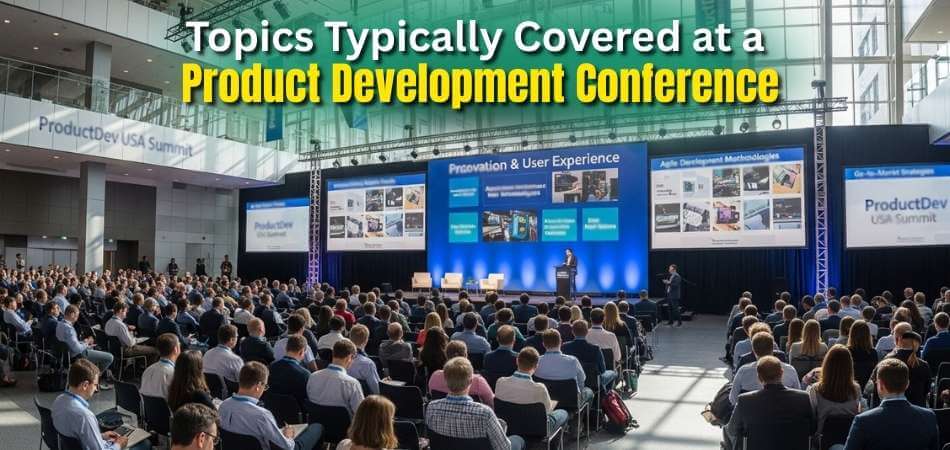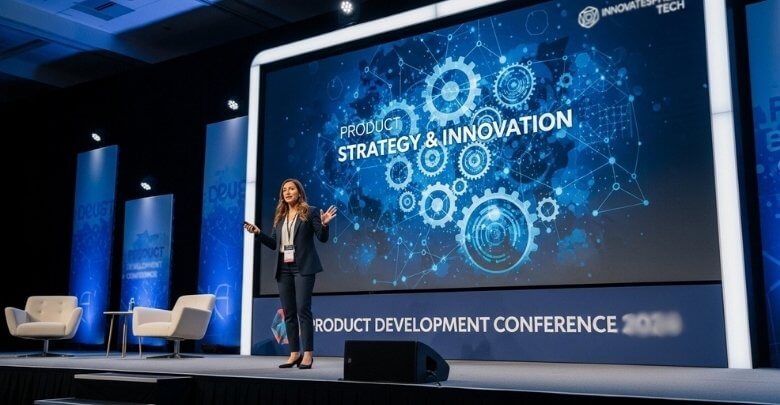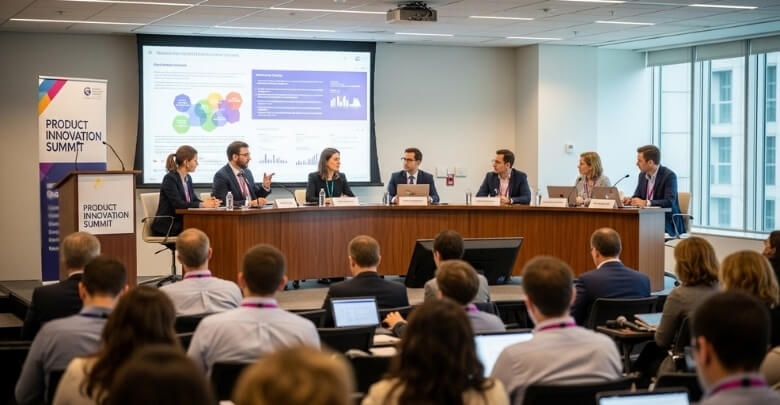Conferences on product development bring together people who want to share knowledge, discuss ideas, and learn about the latest practices. These gatherings cover many areas that shape how products are built and launched. Many readers often wonder what topics are typically covered at a product development conference.
Product development conferences typically cover topics like product strategy, user experience, agile methods, go-to-market plans, team leadership, technology trends, product operations, ethics, and career growth. These sessions help attendees improve skills, launch better products, and build strong professional networks.
Are you curious about how these topics are explained in detail during such conferences? If yes, then this article is the perfect place for you to learn more. Inside, you will find every important detail about these events. This will help you clearly understand why they matter.
What Topics Are Typically Covered at a Product Development Conference?
When people gather for product development conferences, they get to learn, share, and explore new ideas. These events bring together experts, professionals, and learners who want to improve their skills. The sessions cover many different areas that matter in product creation. Let’s see the topics usually discussed at such conferences.
Product Strategy
Experts often explain how to shape a strong vision for products. They show how market research, customer needs, and feature priorities create a roadmap. Sessions also highlight product-led growth and the use of metrics. Attendees learn how data-driven decisions make strategies stronger and help teams achieve real results more effectively.
User Experience
Speakers share ways to design products that are simple and enjoyable. They discuss surveys, interviews, and usability testing as ways to learn user needs. Prototyping and wireframing are explained as steps to refine ideas. Attendees discover how emotional design builds stronger bonds and keeps users returning. These lessons show how design directly affects success.
Technology Trends
Sessions on new technology are some of the most exciting parts. Experts discuss artificial intelligence, machine learning, and the Internet of Things. They explain how these tools shape strategies and open future opportunities. Discussions also highlight fresh software that improves management. Global events, especially for global events like upcoming conferences in Canada, often showcase these new trends.
Agile Methods
Teams need flexible methods to handle challenges and changes in projects. Conferences highlight agile and scrum as popular ways to deliver results faster. Experts describe how short sprints and regular feedback create efficiency. These practices reduce risks and improve adaptability. Attendees leave with proven methods for balancing quality, speed, and innovation without losing sight of the main goals.
Team Leadership
Strong teams are the foundation of any product’s success. Leaders share insights on improving collaboration and supporting creativity in their groups. They talk about solving conflicts, encouraging openness, and boosting communication across departments. Many sessions explain how leadership styles influence teamwork. Attendees gain clear examples of how positive leadership creates productive and motivated environments.
Career Growth
Professional development is a key part of these conferences. Sessions guide attendees on building leadership skills and exploring new opportunities. Experts share what qualities are most valued in product roles today. Networking and mentoring are also discussed as helpful paths to grow. By following these steps, professionals can improve themselves and stay ready for future challenges.
Go-to-Market
Launching products successfully requires careful planning and timing. Experts discuss branding, messaging, and positioning for new launches. They highlight how to connect products with the right audience. Mistakes from past launches are also analyzed to teach lessons. Attendees leave with strategies that build strong campaigns and generate excitement while ensuring long-term customer loyalty and trust.
Product Operations
Sessions also explain how to simplify tasks and workflows within product teams. Experts share ideas on cutting delays, improving clarity, and choosing efficient tools. These methods help avoid wasted time and confusion across groups. Attendees discover how smoother operations boost teamwork and overall output. The focus is always on efficiency that supports better product creation and delivery.
Ethics and Sustainability
Conferences stress the importance of making responsible choices in product creation. Experts explain how sustainable practices reduce harm to the environment. They also discuss designing products with social responsibility in mind. Examples of companies that balance profits with ethics are shared. Attendees learn how these choices build trust and improve the image of brands.
Networking
Many participants value networking as much as the learning sessions. Attendees meet peers, industry leaders, and experts from many fields. These conversations often turn into partnerships, collaborations, or career opportunities. The informal meetings help people share knowledge beyond sessions. Networking allows participants to build strong connections that can support them in future work.
Conferences on product development combine knowledge, skills, and connections into one place. These events provide lessons that help professionals grow in their roles. Attendees also discover the latest industry tools and methods for success. Most importantly, they leave with valuable relationships to support long-term goals.
How Do Product Development Conferences Choose Their Key Themes?
Product development conferences bring new ideas and discussions to the stage every year. But the big question is, how do organizers pick the main topics that set the tone for the event? Let’s explore the factors that shape these choices.
Industry Trends
Organizers often look closely at what is happening in the industry before deciding on themes. If companies are moving toward sustainability, digital tools, or global supply chain changes, those topics often make it to the conference agenda. This keeps events timely and valuable.
Technology Shifts
New technologies are another major factor. If fresh tools like artificial intelligence, 3D printing, or automation start shaping product design and production, these become hot topics. Organizers highlight them because participants want to learn about things that will soon affect their work.
Market Demands
Conferences also pay attention to what customers and markets want. If the market is asking for faster delivery, eco-friendly products, or cheaper options, these demands shape discussions. By focusing on market needs, conferences help participants stay competitive and forward-thinking.
Expert Insights
A big part of understanding product development conferences is knowing how organizers choose their key themes, which are usually shaped by industry shifts, innovation needs, and participant feedback. Organizers also gather advice from leaders who share practical knowledge and experiences that strengthen the overall theme selection.
Attendee Feedback
Past conference feedback also shapes the next event. If attendees say they want more focus on digital transformation, teamwork strategies, or innovation methods, organizers take note. Listening to participants helps build themes that keep people engaged and coming back.
Key themes at product development conferences are not chosen randomly. They are shaped by industry changes, new technologies, market demands, expert advice, and attendee feedback. This mix ensures every conference feels fresh, useful, and worth attending.
Why Are Innovation and Market Trends a Key Focus at Product Development Conferences?
Professionals from many fields come together at product development conferences to share ideas, learn, and stay updated on industry changes. These events highlight both new approaches and changes in the market. Let’s see why these topics are so important.
Fresh Ideas
Conferences are a space where creative minds gather. New concepts, unique methods, and bold solutions are often introduced. These ideas help companies improve their products and think beyond regular methods. Fresh ideas also inspire professionals to keep experimenting and discovering better ways.
Market Shifts
Markets never stay the same. Consumer habits, technology, and global events can all change demand. Conferences help experts talk about these shifts and understand their impact. By studying such changes, businesses can prepare in advance instead of reacting too late.
Business Growth
Innovation and market knowledge directly support business growth. Companies that adapt early often gain an advantage. Conferences guide businesses in planning new products, updating services, or improving customer experiences. Growth becomes easier when decisions are based on fresh knowledge.
Competitive Edge
Staying ahead matters in every industry. Conferences allow companies to learn what their competitors are doing and what customers expect next. This awareness builds confidence and helps businesses position themselves as leaders rather than followers in their field.
Future Planning
Trends are like signs of what might happen next. At conferences, experts discuss future directions in technology, design, and consumer needs. Businesses use these insights to create long-term strategies. This helps them avoid risks and prepare for the future with confidence.
Innovation and market trends are not just buzz topics. They guide businesses in building stronger products, making smarter choices, and staying ahead. That is why product development conferences always keep them at the center of attention.
How Do Conferences Address the Role of Design Thinking in Product Development?
Design thinking is now seen as an important part of building new products. Conferences often highlight how this method helps teams create products that are practical and also user-friendly. Let’s look at how conferences talk about it.
Opening Discussions
Conferences often start by introducing design thinking as a process that puts people first. They show how it focuses on understanding what users need before making decisions. This helps teams avoid mistakes that come from guessing instead of knowing.
Real Case Studies
Many conferences include real company examples to explain design thinking. These case studies highlight both success and challenges. By hearing actual stories, participants see how design thinking was applied and what kind of results it created for products.
Expert Panels
Panels of experts are a common feature at these events. Experienced professionals share their views about design thinking and how it changes product development. Attendees get different perspectives on why this approach works and when it can be most useful.
Hands-on Workshops
Workshops give participants the chance to practice design thinking themselves. Teams work on sample projects and test ideas together. This hands-on style makes it easier for people to understand the method and see how it could help in their own work.
Future Trends
Conferences also talk about how design thinking may change in the future. They explore how new tools, customer habits, and technology can shape the process. This helps participants see not only the present value but also the long-term importance.
Conferences cover design thinking in many ways, from talks and panels to workshops and examples. They aim to show how it connects creativity with practical product development, making it a tool that keeps growing in value.
Do Product Development Conferences Include Research or Academic Contributions?
Product development conferences bring together many types of people. Some are from industries, others are from research backgrounds, and a few may be from academic fields. These events are not limited to just one format or style. To know more, let’s look at the details below.
Research Involvement
Some product development conferences open their doors to research presentations. Researchers often share insights that can help industries improve processes or solve problems. This blend allows companies to stay in touch with the latest findings while researchers get feedback from real-world users.
Paper Submissions
In more research-driven events, participants may even be writing a paper for a Product development conference to share findings with peers. These papers often go through review by experts to make sure the content is strong, useful, and reliable for everyone attending.
Academic Presence
While most attendees come from companies, universities also play a role. Professors and students sometimes present case studies or new methods. This academic presence makes the conference balanced, giving both theoretical and practical perspectives to the audience.
Industry Exchange
On the industry side, conferences highlight hands-on practices and success stories. Businesses present their product designs, testing methods, or market strategies. These sessions complement the academic inputs, creating a full picture of both research and real-world applications.
Knowledge Sharing
What makes these conferences unique is the mix of both research and practice. The result is a platform where people can learn from each other, improve their skills, and build on new ideas. It creates value for both academic and industry participants.
Product development conferences often mix industry talks with research and academic inputs. This blend helps both sides grow while offering attendees a chance to learn from multiple perspectives.
FAQs About What Topics Are Typically Covered at a Product Development Conference?
Product development conferences cover a wide range of topics that help professionals learn and grow. People often have many questions about what exactly these events focus on and why certain subjects are included. Below are some helpful FAQs with clear answers.
What Role Does Data Analytics Play at Product Development Conferences?
Data analytics is often a key topic because it helps companies make smarter decisions. At conferences, experts explain how to collect, study, and use data to improve products. They show real examples of how numbers reveal customer behavior and product performance. Attendees learn how using data makes strategies more reliable and effective.
Why Is Customer Feedback Highlighted in Conference Sessions?
Customer feedback is a common theme because it directly affects how products succeed. Speakers explain methods for gathering feedback through surveys, reviews, and direct communication. They also discuss how feedback can guide updates, features, and design changes. By focusing on real user opinions, businesses avoid mistakes and build stronger connections with customers.
How Do Conferences Discuss Global Market Challenges?
Many conferences include sessions on global market challenges since companies now work across borders. Experts talk about supply chain risks, international rules, and cultural differences in product use. These discussions prepare businesses for unexpected issues that may affect production or sales. Learning about global challenges helps companies stay stable and grow internationally.
What Importance Do Conferences Place on Security in Products?
Security is a big focus because digital products and services face risks from hackers. Experts at conferences explain how to build safer systems and protect user information. They share real cases of companies that improved security after problems. Attendees leave with practical steps to make products more trusted and reliable.
How Is Collaboration Between Teams Addressed at Conferences?
Collaboration is often discussed because creating products requires teamwork across different groups. Sessions highlight how developers, designers, and marketers can work better together. Experts share tips for improving communication, reducing conflicts, and aligning goals. These lessons help companies deliver products more smoothly and with fewer delays.
Why Are Case Studies Shared at Product Development Conferences?
Case studies are shared because they give real-world examples of success and failure. Speakers present stories from companies that tried new methods and explain the outcomes. Attendees get practical lessons they can apply to their own work. Case studies make learning easier by showing how theories work in practice.
What Do Conferences Teach About Testing and Quality Assurance?
Testing and quality assurance are covered to ensure products work as expected. Experts show how testing at different stages reduces problems later. They explain both manual testing and automated tools for faster checks. Attendees understand how focusing on quality builds trust and saves costs over time.
How Do Conferences Talk About Innovation Culture in Companies?
Innovation culture is a common theme because it drives long-term success. Sessions explain how leaders can encourage creativity and allow teams to take risks. They also highlight companies that reward new ideas and experiment with fresh approaches. Attendees learn how culture can make or break innovation in product development.
Why Is Communication With Stakeholders a Topic at Conferences?
Communication with stakeholders matters because product decisions affect many people. Experts explain how to share progress with investors, managers, and customers. They show how clear updates prevent confusion and build confidence. Good communication ensures everyone supports the product and works toward the same goals.
What Role Does Remote Work Play in Product Development Discussions?
Remote work is often discussed because many teams now operate from different locations. Conferences explore tools and practices that keep remote teams connected. Experts talk about balancing time zones, building trust online, and keeping projects moving. Attendees discover how to succeed in product development even without being in the same office.
Conclusion
Product development conferences are more than just events; they are platforms where knowledge, creativity, and practical strategies come together. Attendees gain insights that help them shape stronger products, stay aligned with industry changes, and build meaningful connections. The mix of sessions and activities makes these conferences highly valuable for anyone aiming to grow in this field.
When people ask, what topics are typically covered at a product development conference? The answer is broad but focused. From product strategy and user experience to agile methods, leadership, and sustainability, these conferences cover all major aspects. Each session equips attendees with tools and ideas that can improve real-world practices.
If you plan to attend one, go with clear goals, be open to learning, and take advantage of networking opportunities. Try to connect with speakers and peers, take notes on key lessons, and apply them in your work. Wishing you the best in gaining the most from your next conference experience.








